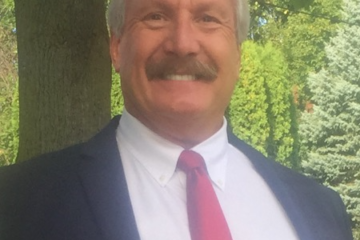REOPENING & RECOVERING: Aspects of disaster recovery from the COVID-19 shutdown
By David Schmiege
I have had countless conference calls with clients over the past 8-10 weeks as practices contemplate the necessary steps to reopen their vein practices and regain their momentum. The COVID-19 pandemic is wreaking havoc on our economy. As with many small businesses, the pandemic has had devastating financial consequences on vein practices. Stay-at-home orders have resulted in postponed vein treatments, office closings and staff furloughs and layoffs.
Several aspects of your employees’ personal lives may be affected by COVID-19. New and unexpected hurdles emerge in their day-to-day routine and understanding these roadblocks can make tough situations easier on your staff. Childcare for parents has been disrupted by school and daycare center closures. In many cases, there are no family members or services they can turn to due to the lockdown.
In some cases, families may be under tremendous financial pressure as a result of going from a dual income to a single income, due to business layoffs. Some businesses may never open again. Whenever possible, allow for more compassion and flexibility for your employees in these times of uncertainty. Any form of relief or aid — information on financial assistance and workplace scheduling flexibility, for example — can genuinely help an employee facing a downturn.

This article will provide a snapshot of the many aspects of your practice that may require attention. The purpose of this discussion is to help you begin with patient and staff safety, while directing your practice back to a solid financial footing. The clinical and business decisions made in the next 3 to 4 months will likely impact your practice, positively or negatively, for the next several years.
FOCUS #1 – PATIENT SAFETY<END BOLD COLOR>
Day prior to appointment
To create additional social distance, adopt a patient check-in process that includes patients waiting in their cars prior to their appointment, instead of your waiting room.
Call the next day’s patients scheduled for appointments. On the day of their appointment, call them when they can be taken right into an exam / procedure room. On the telephone call, ask the following questions:
“Hello (insert patient name), this is (insert Name) calling from (Your Practice Name). The purpose of my call is to confirm your appointment for tomorrow and confirm that you are not experiencing any of the COVID-19 symptoms.
“May I ask you a few questions?”
- Are you experiencing any flu-like symptoms? Any fever in last 24 hours, cough, shortness of breath?
- Have you traveled to a high-risk area in the last (30) days within the United States or Internationally?
- Have you had a fever (100.4°F or higher per CDC), coughing or shortness of breath?
- Have you:
- been in close contact with anyone diagnosed with COVID-19 in the past (14) days?
- live in the same household as a sick person with COVID-19?
- are caring for a sick person with COVID-19?
- in the past (14) days, have been in direct contact with secretions from a sick person with COVID-19 (e.g., being coughed on, kissing, sharing utensils, etc.)
- In the past (14) days, have you shared a healthcare waiting area or exam room with a COVID-19 patient for a prolonged period of time?
If the patient answers yes to any of the above questions, they will need to be rescheduled. If the patient answers no to all of the above questions, move forward with confirming their appointment.
Day of appointment
Office manager will assign staff (anyone available from clinical or front office team) to call patients as they are ready to be treated.
- In the beginning, adjust your appointment scheduling templates to limit the amount of people in your practice at any given time. This will allow you and your staff to adapt to new clinical, administrative and cleaning processes. Solicit feedback from your patients after their appointment to see how their experience was.
- When the patient arrives for their appointment – while in their car, staff will again ask COVID-19 screening questions a-e above.
If the patient answers yes to any of the above questions, they will need to be rescheduled. If the patient answers no to all of the questions, they will be cleared to come into the office. Upon arrival, their temperature will be taken using a ‘no contact’ thermometer and the temperature will be recorder in the medical record, before being escorted to an exam room.
- After the appointment, the patient should remain in the exam/treatment room until staff is ready for checkout or the medical assistant has escorted them out of the clinical and reception area.
- Review your cancellation policies to make them more friendly and encourage patients who are not feeling well to self-opt out of treatment. Make sure you clearly communicate these policy revisions to patients during appointment booking and confirmation.
FOCUS #2 – STAFF SAFETY
Be proactive and ensure you implement Infection Prevention Measures per Centers for Disease Control and Prevention (CDC) guidance:
Disinfect frequently. Disinfect all high-touch surfaces such as countertops, doorknobs, pens, faucet handles, exam tables, chair arms and shared patient equipment with an EPA-approved disinfectant. Disinfect iPads and ultrasound equipment with Sonowipes (or similar), wet to dry 3 minutes.
If a person showing COVID-19 symptoms has left the office, a thorough decontamination of the areas where the person had access should be done. Document all conversations in the medical record.
If a patient calls the office stating they were diagnosed with a contagious respiratory illness after being evaluated or treated at the office, notify the physician immediately. Document all conversations in the medical record.
Establish policies for required use of masks and other personal protective equipment (PPE) in your practice. This should include identifying and documenting which staff should be donning PPE and the intervals at which to change them to ensure safety and establish daily PPE inventory requirements
Plan ahead for sourcing PPE and sanitization products that your practice many need for the next 3-6 months. Actively reach out to your suppliers to find a flexible re-supply mechanism in case of shortages.
Ensure your staff is aware of your practice sick leave policies and encourage any employee showing symptoms (COVID-19 or other) to stay at home instead of coming to work.
Discourage your staff from congregating in the break room and enforce social distancing guidelines where feasible
At the beginning of each day, screen your employees for symptoms related to the coronavirus and provide treatment and guidance accordingly.
Staff should be provided with detailed information – what should be cleaned after each appointment, as well as at the end of the day. Staff should be told what their individual daily responsibilities are and who is responsible for making sure the work gets done. Either at the end of each day or prior to opening the office the next day, a deep cleaning of your treatment rooms and common staff areas should be completed.
Take advantage of electronic patient registration to minimize physical contact with paper during the check-in and check-out process. The goal would be to totally remove the transfer of a virus from paper touching. Require online patient registration or via the phone when scheduling appointments. Co-Pays and past due balances can be taken over the phone when confirming appointments.
To allow for social distancing, ask that only the scheduled patient come to the appointment. For patients under the age of 18, only one parent/guardian may accompany them to the appointment. Appointment times will be managed to allow for social distancing between patients.
When entering the office, the patient will be asked to clean their hands with a hand sanitizer. Additional hand sanitizer will be in the reception area and other locations throughout the office for patient use.
Assuming every patient will be required to wear a protective mask, each practice will need to determine if they will provide masks or require each patient to bring a mask to the appointment. The patient should be educated prior to their appointment of all office policies they must abide by.
All staff should be required to wear a mask during the day. It is also a visual sign to your patients that you are making a continuous effort to also protect them when they are in your environment.
Have a plan for dealing with non-compliant employees and/or patients who refuse to wear a mask or are found taking it off throughout the course of the day or patients who show up without a facial covering or with their children who are not being seen
Consider implementing a telephone triage program to avoid unnecessary patient visits to the practice leading to opportunities for potential exposure
STAFF & SAFETY MEASURES
Providing transparent and concise information to your staff about the measures you are adopting to protect them is crucial. Educating your staff about best practices will lead to a safer and calmer office.
Emphasize health hygiene as a key strategy for slowing the spread of COVID-19. All used PPE need to be properly stored pending cleaning for reuse (when possible, in accordance with your practice’s policies) or properly disposed in waste bins. Touchless bins are useful, in that they significantly reduce direct contact with the surface. Special precautions should be taken when handling these bins; ensure your policy on use of gloves and/or hand sanitizers matches your facility’s equipment.
Users must sanitize their hands before entering an elevator and after if they have touch buttons inside or outside the elevator.
Anyone using stairs should not walk side by side with anyone and should observe at least six feet between them.
Employees should be advised not to touch handrails or disinfect their hands promptly if they do so.
Employees using public transport should observe all lawful instructions regarding physical distancing. It is advisable that employees disinfect their hands and any personal belongings which have been touched during the trip once the public transport has been disembarked.
Employees should be encouraged to conduct self-monitoring of their health.
FOCUS #3 – PRACTICE GROWTH INITIATIVES
ADOPT A TELEMEDICINE PLATFORM
- <set this bold ital>Choose a vendor that is HIPAA compliant.Telemedicine companies are being overrun with requests for setting up new accounts. Some telemedicine companies have features that allow you to prescribe through them and will interface with your scheduling system or EMR. Right now, you can do without those features.

- Equipment needed. A desktop, laptop, monitor, tablet or smart phone, all with a webcam, is really all you will need. This is true for both the physician and for the patient. It is probably easiest if the either has two monitors or a separate computer, so they can document the encounter while they are engaged with the patient.
- Schedule the appointment with the patient. All platforms work in a similar way. The practice will send the patient a link and that will enable them to join your meeting. The email will have a link, as well as the time and day of the appointment.
- Video Appointment. You introduce yourself to the patient and begin a normal discussion as what is bothering them. Some practices may start the video appointment by having a staff member gather information, confirm their history, medications, etc. Then they can pass the patient to you. Some practices have a laptop that is dedicated to the telemedicine appointment that can be moved from Provider to Provider.
- Document Your Visit. The Physician will need to document like normal. History, ROS, Physical (whatever you can actually do/see via telemedicine), and the Assessment and Plan. You will also want to include a statement about this being done via telemedicine in your note.
- Bill for the Appointment. You will bill your regular office visit, keeping in mind that your physical exam is limited by what you can actually do remotely. (Office visit codes: 99202-99215) Then you will bill with the Place of Service code 02, which is for telemedicine.
MESSAGING TO PATIENTS
AND REFERRING PHYSICIANS
< bold ital>Communicate Your Focus on Safety. When communicating re-open information to patients, outline the safety precautions your clinic is taking to ensure a positive in-office experience. Review CDC guidelines to ensure your procedures are in alignment with their recommendations. Use email & social media to keep in touch with patients.
Schedule Changes. If you plan to change your hours for re-opening make sure you communicate changes via social media, email, on your website and in one-on-one interactions with patients.
Most vein practices have already sent out some type of communication letting their patients know how they are handling COVID-19 and their plans for re-opening. It’s time to re-engage patients in what you do best – outstanding vein care with a focus on exceeding patient’s expectations!
Focus narrowly on your value proposition and what you can give patients during this time that vein practices can’t. How is your practice different? Look on social media and see what other practices are doing in your area to understand your competition’s messaging. Look at a cross-section of other types of medical practices to see what they are doing that is unique and attention getting.
Call current and past patients, as well as referral sources. Personal, one-on-one phone calls to check in and see how they are doing is priceless. Ask how they are and see if you can help them with anything. You might be surprised how they respond – I predict that a variety of marketing ideas will come to you during this effort. process.
Be a leader in your community. Your medical practice needs to instill trust through stability in times of turmoil. Make your patients and referral sources feel comfortable that you have a handle on your practice and that your focus on them is unwavering. Your patients and referral sources are facing the same issues that you and your staff are. Your messaging needs to convey that you will work through the current situation together.
Don’t make political or governmental comments. Everyone’s stress levels are through the roof due to the uncertainty as to what the future holds. No one enjoys being around negative people, focus instead on appreciating those keeping us safe and expressing hope for a bright future.
HIRE A MEDICAL LIAISON TO
CULTIVATE PHYSICIAN REFERRALS
If you have the means to hire a medical liaison, there are several best practices to follow to maximize your ROI:
<bold, ital>Track referrals – Track referrals to determine ROI and to reconnect with referrals who aren’t actively working with you.
Consistent field visits — By nature, the medical liaison position comes with a large amount of autonomy. When hiring a Medical Liaison, they need to be self-managed and self-directed. They build relationships by being in the field, not in the office. Put them in scrubs as part of your clinical care team to hand deliver consult and post-procedure reports to referring group practices. Face-to-face conversations are the key to physician referrals. PCPs want to build a relationship. They don’t send to buildings, they don’t send to institutions – most of the time, they are sending to a physician whom they have a relationship with, because they have to trust them with their patient.
Clear difference — A vein practice won’t grow by being as good as its competitors; it must constantly differentiate itself from its competitors. Articulate your value to PCPs. Beyond differentiating your practice, you must be able to use data to assess what makes you better.
Communicate clinical depth — For a Medical Liaison to be successful, they must be able to help change referral patterns by communicating their knowledge of vein disease and treatment options available. The liaison should know what makes your practice different and be able to discuss treatment options on a particular type of patient.
Hire carefully –You can teach a liaison about vein disease and treatment options, but you will not have the time or skill set to teach them how to sell. Make sure you hire talented salespeople.
FOCUS #4 – MARKETING
There will be two types of vein practices emerging from this pandemic. The first is a practice that does nothing to prepare for re-opening. Once shelter-in-place (SIP) is lifted, that practice will simply re-open and hope that patient flow returns to normal. That might happen, especially if given enough time, perhaps a matter of months.
The second type of vein practice wants or needs to open with maximum throughput as soon as possible, considering limitations by practicing social distancing. This practice wants to get patients in the door, get staff back to work, and return to prior levels of profitability or greater, as soon as possible, since June through September consults drive Q3 and Q4 revenue.
Medical marketing has moved towards providing fantastic patient experiences that will keep a positive buzz around your practice. The growth of online content has given patients more knowledge and confidence in selecting a provider. In many instances, they are no longer asking their PCP for a referral. Instead, they’re going out and doing their own research. So, you have to offer them something more than information. Patient satisfaction should be an important focus of your practice. You should consider patient satisfaction in every aspect of your marketing strategy.
Your employees are the face of your practice, so concentrating on interactions between your employees and your patients should be a key part of your marketing strategy. When you’re turning the responsibility of creating ongoing patient satisfaction over to your employees, you need to make sure that they want your practice to succeed as much as you do.
The key to this is taking steps to ensure that every employee understands and is aligned with your vision and values. You can’t expect your employees to care about your patients if they’re not happy at work and don’t really believe that your focus in on creating patient satisfaction. Achieving a high level of employee engagement is the first and most important step in improving patient satisfaction throughout every aspect of your practice.
An important part of achieving ongoing patient satisfaction is making sure that you focus on current patients, rather than just attracting new ones. Satisfied patients help to increase the reputation and awareness of your practice as they talk about their treatment with their friends and family. Happy patients and referral physicians are valuable practice ambassadors and influencers.
Branding with newsletters. If you are thoughtful about the information you include in your patient newsletters, they can actually be a great tool for branding your practice as the experts in the area. In fact, it is actually a very effective way to foster stronger relationships, increase loyalty. and obtain quality patient referrals. The more you customize and personalize the content of your newsletters, incorporating facts and information relevant to trending health concerns or benefits, the more valuable a resource your newsletters will be.
A quarterly or monthly newsletter will enhance the long-term success of your patient relationships and ultimately increase the income generated for your practice resulting from new patient referrals. In addition, your newsletters will likely assist you in reducing your attrition by more effectively engaging your patients and reducing no-shows and cancellations.
Don’t forget your referring doctors. A personalized newsletter (with clinical and practice data)(with clinical and practice data) sent to your referring doctors will also foster solid, positive relationships with them and ensure an effective and consistent means of reinforcing your referral relationships. Your referring doctors are real people too…make sure that the information you include in their newsletters is just as engaging and personal in order to strengthen that source of new business to support you in achieving maximum success in new patient acquisition efforts.
Develop strong patient relationships to improve their commitment to your practice. Sending birthday and holiday wishes is one method but offering ongoing information through your website or patient portal is another. You can also use a patient newsletter to keep patients current on events in your office as well as offer healthcare tips they can use immediately. When patients feel valued, when they feel that you take an interest in them individually, they are considerably less likely to become a no-show.
Think digital. This is more than just having a website. It means electronic record-keeping, automated appointment reminders, a calendar for publishing helpful content, and a strategy for appearing in local search (including informing search engines and curating patient reviews). The fastest-growing practices are embracing their online identities and reaching out to patients, new and current, through online media.
Local SEO. Most people find a vein specialist by going online. Google (and Google My Business) play a large role in what they find. Be sure your practice is listed correctly and optimized to be prominent in local search.
Convert inquiries to consultations. Do you have the best talent available answering your phones and scheduling appointments? If your average revenue per patient is $2500 to $3500, you cannot afford to miss scheduling interested patients. Your team needs to be able to confidently sell a consultation appointment by promoting the benefits to the potential patient, rather than being drawn into “vein/vascular” conversations.
Surprisingly, a significant number of staff never invite potential patients to make an appointment with the practice. Once the patient stops asking questions, the call promptly ends, and the prospective patient is lost. While it cannot be assumed that all patients are ready to make an appointment, it is critically important that staff members not lose the potential opportunity to “close” the caller at some point in the future. If an attempt to schedule the appointment is declined by the caller, the staff member should respect the decision-making process of the potential patient and add, “We understand this is a big decision. I would love to add you to our newsletter list so you can receive future communications from our office regarding special events and promotions. May I get your email address?” Capturing the caller’s email address ensures that the practice’s name continues to be top of mind when the patient is ready to make a future appointment.
Providing your staff with techniques to help them develop the verbal skills required to sell the consultation appointment will boost their confidence and convert more inquiries into appointments.
Stay focused. Stop chasing dozens of new marketing ideas! Two or three new initiatives, planned and executed well, will bring you more success than marketing without a vision. Look at your practice, look at your competitor’s marketing efforts, form a strategic action plan, and implement. Monthly analytics will tell you what is working, what is not, and what to tweak. When your marketing is consistent, meaning you have processes in place that actively reach out to prospective and current patients on a continuous basis, you improve the health of your patient base, while increasing revenues.
<bold, ital>Call, text and email patients whose appointments were canceled and re-book them now. Tell patients who have been wearing compression stockings that have now satisfied their (90) day conservative treatment and are approved to be scheduled for treatment.
WEBSITE DEVELOPMENT
Promote private virtual consultations. Include a medical assistant in the process. At the end of the discussion, the MA can schedule the consultation. This will accelerate revenue collection and ramp the practice up faster.
- Add information to make people comfortable to come to the practice – cleanliness standards, COVID-19-related protocols, etc.
- Add online scheduling if it doesn’t exist already.
- Add video content, particularly a “welcome back” message.
- Update office hours and COVID-19 protocols concerning patients coming into your office.
- Update content with Q&A format.
- Consider creating an ongoing email marketing campaign to improve communication with your patients to maintain top-of-mind awareness.
- Consider running paid advertising to jump-start patients coming in the door. Establish a budget and select the procedures to advertise.
- Launch homepage banners advertising that you are open, seeing patients, and highlight your new office hours.
You will have patients who are ecstatic you are back open. Their enthusiasm is a fantastic opportunity to request video testimonials and positive social media reviews. Make sure to ask each and every happy patient for a review. VTN

David Schmiege
David Schmiege is the founder, president and CEO of Vein Specialists of America (VSA). Since 2011, David has been a trusted and valuable contributor to Vein Therapy News by developing the “Business Side of Medicine” feature. He embarked on his first business venture at the age of 25, launching, scaling and later selling a successful office equipment company with three locations. In 1985, he formed MD Management to provide practice management consulting and advisory services to office- and hospital-based practices. What began as a division of MD Management, transitioned to a separate company in 2002, when VSA was formed to focus exclusively on the needs of vein and vascular practices nationwide.
David is a member of the VTN Editorial Advisory Board.






